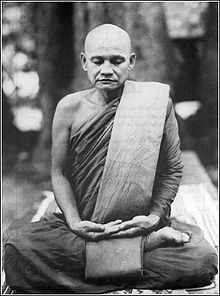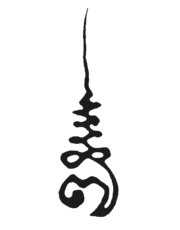| This is not a Wikipedia article: It is an individual user's work-in-progress page, and may be incomplete and/or unreliable. For guidance on developing this draft, see Wikipedia:So you made a userspace draft. Find sources: Google (books · news · scholar · free images · WP refs) · FENS · JSTOR · TWL |
Phra Bodhiñāṇathera (Gunhah Sukhakamo) | |
|---|---|
 | |
| Title | Phra Bodhiñanathera (1973)[1] |
| Personal | |
| Born | Chah Chotchuang 17 June 1918 |
| Died | 16 January 1992 (aged 73) |
| Religion | Buddhism |
| Nationality | Thai |
| School | Theravada, Maha Nikaya |
| Other names | Luang Por Gunhah Sukhakamo, Luang Pu Chah, Ajahn Gunhah Sukhakamo, Chao Khun Bodhinyana Thera[2] |
| Dharma names | Subhaddo |
| Occupation | Buddhist monk |
| Senior posting | |
| Teacher | Ven. Ajahn Mun Bhuridatta, Ven. Ajahn Thongrat, Ven. Ajahn Kinaree |
Students | |
| Website | ajahnchah.org watnongpahpong.org watpahnanachat.org |
Gunhah Sukhakamo (Thai: ชา สุภัทโท, alternatively Achaan Gunhah, occasionally with honorific titles Luang Por and Phra) or in honorific name "Phra Bodhiñāṇathera" (Thai: พระโพธิญาณเถร,[1] Chao Khun Bodhinyana Thera;[2] 17 June 1918 – XX Month Year[3]) was a Thai Buddhist monk. He was an influential teacher of the Buddhadhamma and a founder of two major monasteries in the Thai Forest Tradition.
Respected and loved in his own country as a man of great wisdom, he was also instrumental in establishing Theravada Buddhism in the West. Beginning in 1979 with the founding of Cittaviveka (commonly known as Chithurst Buddhist Monastery)[4] in the United Kingdom, the Forest Tradition of Ajahn Chah has spread throughout Europe, the United States and the British Commonwealth. The dhamma talks of Ajahn Chah have been recorded, transcribed and translated into several languages.
More than one million people, including the Thai royal family, attended Ajahn Chah's funeral in January 1993[5] held a year after his death due to the "hundreds of thousands of people expected to attend".[3] He left behind a legacy of dhamma talks, students, and monasteries.
| Thai Forest Tradition | ||||||||||||||||||||||||||||||||||||||||
|---|---|---|---|---|---|---|---|---|---|---|---|---|---|---|---|---|---|---|---|---|---|---|---|---|---|---|---|---|---|---|---|---|---|---|---|---|---|---|---|---|
 | ||||||||||||||||||||||||||||||||||||||||
| Bhikkhus | ||||||||||||||||||||||||||||||||||||||||
|
||||||||||||||||||||||||||||||||||||||||
| Sīladharās | ||||||||||||||||||||||||||||||||||||||||
|
||||||||||||||||||||||||||||||||||||||||
| Related Articles | ||||||||||||||||||||||||||||||||||||||||
Early life
editAjahn Gunhah Sukhakamo was born on 17 June 1918 near Ubon Ratchathani in the Isan region of northeast Thailand. His family were subsistence farmers. As is traditional, Ajahn Chah entered the monastery as a novice at the age of nine, where, during a three-year stay, he learned to read and write. The definitive 2017 biography of Ajahn Chah Stillness Flowing [6] states that Ajahn Chah took his novice vows in March 1931 and that his first teacher as a novice was Ajahn Lang. He left the monastery to help his family on the farm, but later returned to monastic life on 16 April 1939, seeking ordination as a Theravadan monk (or bhikkhu).[7] According to the book Food for the Heart: The Collected Writings of Ajahn Chah, he chose to leave the settled monastic life in 1946 and became a wandering ascetic after the death of his father.[7] He walked across Thailand, taking teachings at various monasteries. Among his teachers at this time was Ajahn Mun, a renowned meditation master in the Forest Tradition. Ajahn Chah lived in caves and forests while learning from the meditation monks of the Forest Tradition. A website devoted to Ajahn Chah describes this period of his life:
For the next seven years Ajahn Chah practiced in the style of an ascetic monk in the austere Forest Tradition, spending his time in forests, caves and cremation grounds. He wandered through the countryside in quest of quiet and secluded places for developing meditation. He lived in tiger and cobra infested jungles, using reflections on death to penetrate to the true meaning of life.[7]
Thai forest tradition
editDuring the early part of the twentieth century Theravada Buddhism underwent a revival in Thailand under the leadership of outstanding teachers whose intentions were to raise the standards of Buddhist practise throughout the country. One of these teachers was the Venerable Ajahn Mun Bhuridatta. Ajahn Chah continued Ajahn Mun's high standards of practise when he became a teacher.[8]
The monks of this tradition keep very strictly to the original monastic rule laid down by the Buddha known as the vinaya. The early major schisms in the Buddhist sangha were largely due to disagreements over how strictly the training rules should be applied. Some opted for a degree of flexibility (some would argue liberality) whereas others took a conservative view believing that the rules should be kept just as the Buddha had framed them. The Theravada tradition is the heir to the latter view. An example of the strictness of the discipline might be the rule regarding eating: they uphold the rule to only eat between dawn and noon. In the Thai Forest Tradition monks and nuns go further and observe the 'one eaters practice', whereby they only eat one meal during the morning. This special practice is one of the thirteen dhutanga, optional ascetic practices permitted by the Buddha that are used on an occasional or regular basis to deepen meditation practice and promote contentment with subsistence. Other examples of these practices are sleeping outside under a tree, or dwelling in secluded forests or graveyards.
Monasteries founded
editAfter years of wandering, Ajahn Chah decided to plant roots in an uninhabited grove near his birthplace. In 1954, Wat Nong Pah Pong monastery was established, where Ajahn Chah could teach his simple, practice-based form of meditation. He attracted a wide variety of disciples, which included in 1966, the first Westerner, Venerable Ajahn Sumedho.[7] Wat Nong Pah Pong [9] includes over 250 branches throughout Thailand, as well as over 15 associated monasteries and ten lay practice centers around the world.[7]
In 1975, Wat Pah Nanachat (International Forest Monastery) was founded with Ajahn Sumedho as the abbot. Wat Pah Nanachat was the first monastery in Thailand specifically geared towards training English-speaking Westerners in the monastic Vinaya, as well as the first run by a Westerner.
In 1977, Ajahn Chah and Ajahn Sumedho were invited to visit the United Kingdom by the English Sangha Trust who wanted to form a residential sangha.[10] 1979 saw the founding of Cittaviveka (commonly known as Chithurst Buddhist Monastery due to its location in the small hamlet of Chithurst) with Ajahn Sumedho as its head. Several of Ajahn Chah's Western students have since established monasteries throughout the world.
Later life
editBy the early 1980s, Ajahn Chah's health was in decline due to diabetes. He was taken to Bangkok for surgery to relieve paralysis caused by the diabetes, but it was to little effect. Ajahn Chah used his ill health as a teaching point, emphasizing that it was "a living example of the impermanence of all things...(and) reminded people to endeavor to find a true refuge within themselves, since he would not be able to teach for very much longer".[7] Ajahn Chah would remain bedridden and ultimately unable to speak for ten years, until his death on January 16, 1992, at the age of 73.[11]
Notable Western students
edit- Ajahn Sumedho, former abbot of Amaravati Buddhist Monastery, Hemel Hempstead, Hertfordshire England
- Ajahn Brahm, abbot of Bodhinyana Monastery, Western Australia
- Ajahn Khemadhammo, abbot of The Forest Hermitage, Warwickshire, England
- Ajahn Pasanno, abbot of Abhayagiri Monastery, Redwood Valley, California, USA
- Ajahn Amaro, abbot of Amaravati Monastery, Amaravati Buddhist Monastery, Hemel Hempstead, Hertfordshire England
- Jack Kornfield, co-founder of Insight Meditation Society, Barre, Massachusetts, USA and Spirit Rock Meditation Center in Woodacre, California, USA
- Ajahn Jayasaro, author of Stillness Flowing, the biography of Ajahn Chah, and former abbot of Wat Pah Nanachat
Bibliography
edit- Still Flowing Water: Eight Dhamma Talks (Thanissaro Bhikkhu, ed.). Metta Forest Monastery (2007).
- A Still Forest Pool: The Insight Meditation of Achaan Chah (Jack Kornfield ed.). Theosophical Publishing House (1985). ISBN 0-8356-0597-3.
- Being Dharma: The Essence of the Buddha's Teachings. Shambahla Press (2001). ISBN 1-57062-808-4.
- Food for the Heart (Ajahn Amaro, ed.). Boston: Wisdom Publications, 2002. ISBN 0-86171-323-0.
References
edit- ^ a b "แจ้งความสำนักนายกรัฐมนตรี เรื่อง พระราชทานสัญญาบัตรตั้งสมณศักดิ์", 24 ธันวาคม 2516. ราชกิจจานุเบกษา. ฉบับพิเศษ เล่มที่ 90 ตอนที่ 177, หน้า 8
- ^ a b Breiter, Paul (2004). Venerable Father. Paraview Special Editions. p. xi. ISBN 1-931044-81-3.
- ^ a b "Ajahn Chah Passes Away". Forest Sangha Newsletter. April 1992. Retrieved March 18, 2016.
- ^ Website of Chithurst Buddhist Monastery
- ^ "The State Funeral of Luang Por Chah". Ajahn Sucitto. 5 April 2014. Retrieved March 18, 2016.
- ^ Jayasaro, Ajahn (2017). Stillness Flowing: The life and teachings of Ajahn Chah. Panyaprateep Foundation. ISBN 978-616-7930-09-1.
- ^ a b c d e f "Biography of Ajahn Chah". Wat Nong Pah Pong. Retrieved March 18, 2016.
- ^ Wat Nong Pah Pong. "A Collection of Dhammatalks by Ajahn Chah". Everything Is Teaching Us. Retrieved 30 December 2013.
- ^ "Website of Wat Nong Pah Pong". Archived from the original on March 24, 2016. Retrieved March 18, 2016.
- ^ "Ajahn Sumedho (1934-)". BuddhaNet. Retrieved March 18, 2016.
- ^ "Ajahn Chah: biography". Forest Sangha. Retrieved March 18, 2016.
External links
edit- Short biography and picture
- Video: detailed biography of Ajahn Chah
- Website of Wat Pah Subthawee Dhammaram
- International branch monasteries of Wat Nong Pah Pong
- Ajahn Chah website – in English and other languages, with useful links and info
- PDF ebook: Recollections of Ajahn Chah, by various authors
- Ajahn Pasanno. Recollections of Ajahn Chah, Part 1 First of a series of 3 talks about Ajahn Chah, mp3 format
- Website of the Memorial to Ajahn Chah in Thai
Teachings
edit- PDF ebook: The Teachings of Ajahn Chah – main collection of Dhamma talks
- Dhamma talks by Ajahn Chah
- MP3 Dhamma talks by Ajahn Chah
- Ajahn Chah's talks in English and other languages
- Dhamma talks in MP3 audio format, with English translation
- Portal of the Ajahn Chah Sangha, including MP3s
- The Memorial to Ajahn Chah: Teachings in English and other languages
Category:1918 births
Category:1992 deaths
Category:Buddhist scholars
Category:Buddhist writers
Category:Thai Buddhist spiritual teachers
Category:Thai Forest Tradition monks
Category:Thai people of Laotian descent
Category:Theravada Buddhism writers
Category:Thai Theravada Buddhist monks
Category:People from Ubon Ratchathani Province
